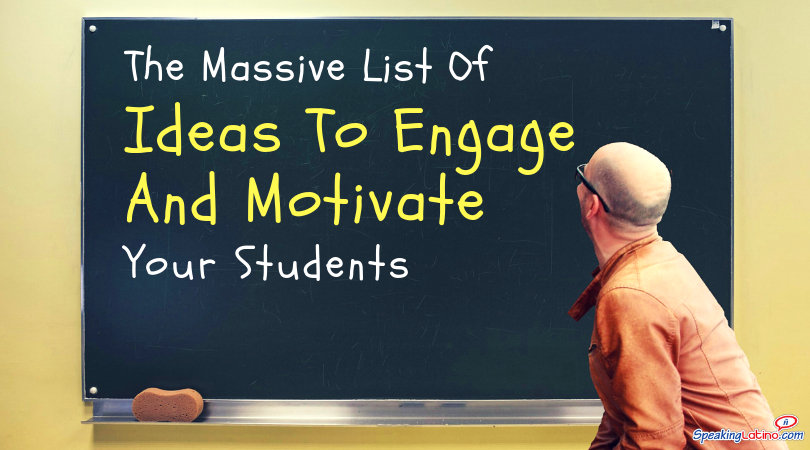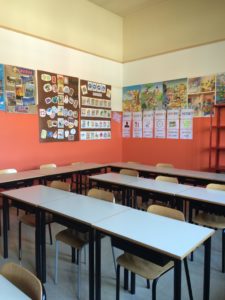
Creating a dynamic and engaging learning environment is essential for motivating students and fostering a love for Spanish learning. We will explore a massive list ideas and strategies to engage and motivate students in the classroom.
1. Take Action Now
To set the tone for success and kickstart a successful learning journey, it is crucial for educators to be enthusiastic and passionate about their subject matter. By acknowledging difficult concepts and demonstrating a spirit of openness towards challenges, teachers can inspire students to approach learning with a positive mindset from the outset.
- Be enthusiastic. All the time.
- Acknowledge difficult concepts.
- Model a spirit of openness towards challenges.
- Wear something out of the ordinary. Ask students if they notice anything different about you. Engage the topic of fashion for 3 minutes.
- Send positive notes home to parents about their student’s performance and/or behavior.
- Look for unexpected ways to praise students publicly, like in the school newspaper or at an assembly.
- Close the textbook and teach with found objects, realia, or your imagination whenever possible.
- Incorporate physical movement into your lessons.
- Create a cultural calendar with your students to help them discover important cultural holidays from the Spanish-speaking countries.
- Foster your students’ love of whatever it is they love, even if it isn’t Spanish.
- Notice when a student is struggling and offer to help.
- Tell your students you believe in them, often.
- Choose to interpret student laziness as evidence of their discouragement, not disrespect.
- Survey students about their hobbies, favorite foods, sports, etc.
- Ask for student feedback about lessons and projects.
- Insist on total silence and complete attention when giving instructions. Practice this technique for low-value tasks to ensure the high-value ones come across clearly.
- Make sure students know that put-downs are not welcome in your classroom.
- Every now and then, ask students to spend the last 5 minutes of class reflecting on how things are going and writing down what is going well and what needs improvement.
- Every day, ask students a question they all must answer with an agree/disagree/I’m not sure response.
- After asking a question, always leave enough time for students to answer. Brief silences are okay.
2. Rapport-building tips
Establishing connections with students and building strong relationships with them is key to creating a supportive and inclusive classroom environment. Getting to know your students, giving them options, and praising their unique ideas can help foster a sense of belonging and empowerment. By setting high expectations, checking in with students regularly, and showing appreciation for their efforts, educators can cultivate a positive rapport that motivates students to excel.
- Get to know your students. (Here’s a questionnaire to help.)
- Give students options when possible so they feel more in control.
- Praise unique ideas for their uniqueness.
- Vote on a classroom mascot and refer to it often to build team spirit.
- Set and voice high expectations.
- Give students all the credit for meeting high expectations, even when you have helped them a lot.
- Check in with students to find out what they like/dislike.
- Bring treats to class, once in a while, for no reason at all.
- Reward positive behaviors you observe outside of your classroom.
- Don’t over-correct students when they make mistakes.
- Thank students when they volunteer to answer a question even if their answer is wrong.
- If a student mentions a problem, listen for as long as the student needs to talk.
- Give older students stickers for a job well-done.
- Bribe students with a suitable YouTube video of their selection, but only if everyone completes their homework; preview video before showing to class!!
- Once every two weeks, do a team-building activity that has nothing to do with Spanish.
- Practice unconditional positive regard.
3. Tips regarding classroom/environment
The physical environment plays a significant role in student engagement and next are some tips to create a stimulating learning space. By changing up the classroom setting occasionally, incorporating physical movement into lessons, and creating a cultural calendar to explore diverse holidays, teachers can make learning more interactive and culturally enriching. Additionally, decorating the classroom, incorporating language games, and using music can enhance the overall learning experience and keep students actively involved.
- Change the environment once in a while by going outdoors or to a different room.
- Visit a local restaurant and let your students read the menu and speak to some of the staff in Spanish.
- Plan eight to ten different activities for one class period, each lasting 5 minutes long.
- Assign classroom jobs. This can be a great way to involve the least motivated students.
- Create incentives: the students who do everything they are supposed to and act right can be in charge of ________ (something high-value).
- Display good work in the classroom.
- Create awards for non-academic successes.
- Hold non-academic award ceremonies in your classroom.
- Change the seating chart without any warning… or even more extreme, have students stand and move around for one class period, no chairs or desks!
- Make sure the classroom space is inviting; decorate a boring environment.
- Trade classes with a fellow Spanish teacher without warning students in advance.
- When students are working on a project in class, give them space on the wall for storyboarding and posting visuals of their work.
- Create a cultural corner in your classroom with items that represent various Spanish-speaking countries.
4. Learning and outcome/lesson planning tips
Maximizing student success and tracking student improvement, bringing in guest speakers, and emphasizing tests and quizzes as learning opportunities are essential aspects of effective lesson planning. By providing clear instructions, offering choice in project topics, and connecting lessons to students’ lives, educators can empower students to take ownership of their learning journey and strive for academic excellence.
- Figure out a way to track improvement that is appropriate for your level of student.
- Bring in guest speakers to talk about how learning Spanish applies to the real world.
- Emphasize tests and quizzes as opportunities for students to demonstrate their knowledge (rather than as ways to highlight gaps in learning.)
- Avoid using a curve to grade student work.
- Let students choose their own project topics.
- Tell students when they will be using a concept over and over.
- Help students achieve high expectations.
- Mix it up. Any way at all.
- Take advantage of any opportunity in the year to make the Spanish language and culture an event in class. For example, celebrate Spanish Language Day, Foreign Language Week, poetry month, Hispanic Heritage Month, Dr. Seuss Day, carnivals, Earth Day, etc.
- Connect lessons to the lives of students.
- Talk to your principal about cash incentives for achievement; there may be some money available for a fabulous field trip, and students can earn their trip over time with good behavior and academic performance.
- Give exceptionally clear instructions. All the time. Write them on the board if necessary.
- Plan a class service project that benefits the school as a whole.
- Make a typical dish at home and bring it in one day.
- Incorporate language games that encourage participation and gentle competition.
- Only assign homework that actually helps students learn something.
- When parents call about their students, offer specific and practical advice if they ask.
- Practice Spanish conversation with improv games.
- Design a lesson plan with your school librarian and have a class in the library.
- Create contracts with older students that clarify how a student will earn a particular grade, step by step.
- Use music in class. Songs are great for getting students to move and dance, practice listening comprehension and exploring the culture.
- Assign students an easy warm-up task to complete as soon as they enter the classroom.
- Create an activity where the students need to find mistakes. Celebrate their expertise.
- Ask questions that allow for multiple answers or explanations.
- Minimize dead time.
- Use exit slips.
- For note-taking, give students incomplete handouts that they must fill in with the correct information. Space out the blanks in unpredictable ways to focus their attention.
- Give students a menu of homework items from which to choose.
- Design and distribute response cards for students to fill in answers to questions and turn them in instead of raising their hands.
- Incorporate self-monitoring into your teaching.
- Keep track of important holidays from the Spanish-speaking world on the class calendar to incorporate them into your lessons or mention them in class.
Sustaining Motivation Over Time
To maintain student motivation throughout the academic year, it is important to mix up teaching methods, celebrate cultural events, and offer incentives for academic achievement. By engaging students in reflection activities, encouraging self-monitoring, and incorporating interactive elements like exit tickets and response cards, teachers can keep students actively involved and invested in their learning.
Engaging and motivating students is a multifaceted process that requires creativity, dedication, and a genuine passion for teaching. By implementing the strategies outlined in this list, you can create a vibrant and inspiring learning environment that empowers students to reach their full potential.
By building rapport, optimizing the classroom environment, and fostering a culture of continuous engagement, you can cultivate a love for the Spanish language that extends far beyond the classroom walls.
Click here for more insights on how to teach Spanish.



